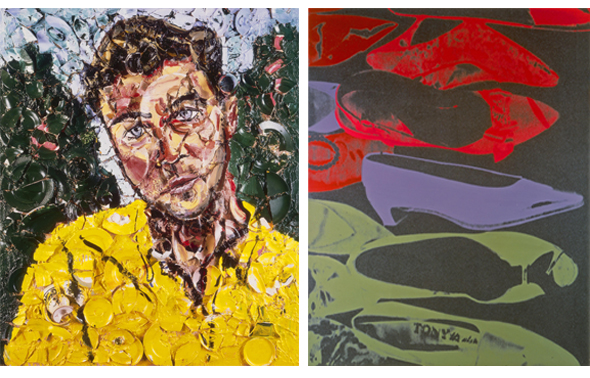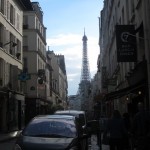I’m reading Teresa Eckmann’s fabulous book Neo-Mexicanism: Mexican Figurative Painting and Patronage in the 1980s, where she introduced me to these amazing image from a state-sponsored Mexico86 World Cup advertising campaign that I’ve never seen before. Still working through an interpretation of these.
Category Archives: Graduate School
private collectors
I really need to get started writing this article, but I just came back from a field trip to the private collection of Matthew and Iris Strauss (see also here) and I feel the need to process. To back up a bit, I’m a visiting scholar at UCSD’s Center for US-Mexican Studies this year — a huge honor — and to try and take advantage of my affiliation here I am auditing a class on curatorial practice taught by MCASD director Hugh Davies. The class is phenomenal and the final project is to design an exhibition based on MCASD’s permanent collection that, if chosen, might be selected to be actually put on exhibit. Is that not the coolest thing ever?
Anyway, the class is awesome because we’re learning both theoretical and practical skills of curating — something that I’m eager to learn more about. Today’s class was a visit to the Strauss collection and it was really breathtaking. My favorite piece is definitely Fred Wilson’s Picasso/Whose Rules, though I was also impressed by the amazing array of contemporary art, much of it newer artists that I was less familiar with. One thing that my visit put into relief is that writing a dissertation will definitely give you a more narrow view (“specialized” is the polite term) of art because you’re really focusing on a few artists (and even then, a few works from their oeuvre). Plus, you tend to forget about the business side of things and the importance of private collectors. I’ll have to ruminate on this a bit more, but I am really impressed by the eye of the Strauss’s and their commitment to art and especially local audiences in San Diego. Wealthy individuals have the ability to spend their money on anything, so it is quite admirable when they spend it on art collecting with an eye toward benefiting the larger good.
pterodactyl badge
It’s official. I’ve written for 200 days in a row on 750words.com. That’s the longest streak and I’m extremely proud of it. It really is amazing how this simple act of staring at a blank screen every day for 200 days and managing to write something (anything, really), has helped me avoid writer’s block and get 3 chapters of my dissertation written. Of course, there’s more to successful writing than just 750words.com, but I do credit it with helping me get through these last months.
In other dissertation writing news, I would also say that Demystifying Dissertation Writing is also a great resource for anyone who is either starting or in the process of writing a dissertation. This is especially true if you’re like me and prefer a systematic approach to writing. I really like her writing chart in which you chart the time that you write in short blocks (15-20 minutes) and the process from interactive note taking –> focus statement –> short outline –> long outline –> draft. Her tips make a lot of sense, she incorporates real classroom anecdotes, and the book is available at at reasonable price.
Two other things that have helped over the last few months are: (1) my dissertation writing group and (2) the Pomodoro technique. My dissertation writing group started at the beginning of the spring semester and we meet twice a week. We set goals together, chart progress, hash out frustrations, and do fun exercises from books like Stylish Academic Writing. We’re going to start experimenting with a help-line through Google Hangout because sometimes it’s just easier to work while you know someone else is (virtually) with you.
Whenever I can’t seem to get started working, I just start a Pomodoro (25 minute block of time). I use the Promodoro! App, which I really like, though there are plenty others to choose from. After 25 minutes of working, I take a 5 minute break for stretching or checking email. After 4 rounds of 25 minutes, the app gives you a 15 minute break. In the morning, I usually get through about 4 pomodoros easily, and stretch it to 6 if I’m really on a roll.
a decolonial approach to visual culture talk
Last week, I gave a talk as part of the Visual Studies Research Initiative at USC. I was really nervous because I was sharing my ideas about decolonial approaches to visual culture with my colleagues and professors, and I had been preparing for months. I envisioned creating a different kind of space for knowledge exchange and production, so I came up with the idea of a dinner party — which was also timely considering it was the end of the year and a good moment for celebrating this year’s accomplishments. The talk turned out better than expected and people responded well to the Devil Wears Prada clip and the three artists who I presented on. I was worried that audience members might have negative reactions to decoloniality, but it was quite the opposite, as I found most of my colleagues genuinely wanted to learn more about the decolonial project. They offered some great comments and questions at the end and I received many congratulatory hugs. Now I just have to figure out how to spend the $250 gift certificate to the USC bookstore that I received as an honorarium!
rebecca’s coffee shop
One essential component to grad school success is having a local coffee shop with an extensive selection of tea, good food, and free & reliable wifi. Even though I have a designated room as an office at home complete with an ergonomic chair, scanner / printer combo, and lap cat, it’s really hard for me to do serious writing there. Reading is fine, and it’s good for busy work too. But there’s something about being in a coffee shop surrounded by other people on their laptops that begs you to be productive. I have a habit of falling in love with one coffee shop at a time — lately, it’s been Rebecca’s in South Park. I maintain a monogamous relationship with said coffee shop until the chairs get a bit stiff and the clientele too familiar, and then it’s off to another.
late november
It’s that time of year when students & professors go into stress-mode. That special time between Thanksgiving and Christmas when you’re realizing that you only have a few weeks before the end of the semester. Which is great, but at the same time, extremely frightening. As an ABD student, I don’t often work along the same time frame, since I’m neither teaching nor in coursework. And I live about 100 miles from campus. But like some sort of persistent muscle memory, I still have the feeling like I’m supposed be busy and on deadline — and in some ways I am. I scheduled two talks late into the semester — one at the USC Fisher Museum of Art (above) and one next week on “A Decolonial Approach to Visual Culture.” These talks are not only a good way to disseminate my work to my fellow USC colleagues, but also function as built-in deadlines. Kind of like conference papers or fellowship deadlines.
The next major goal is to write Chapter 2 by the time I’m getting ready to leave for Vietnam. I have about 16 days to get this done, which seems kind of impossible. But I’m talking a draft — nothing perfect. The polishing can be done later. I just feel like if I don’t get all of my thoughts down before my trip, then I’ll forget them and lose some of the momentum that I’ve had over this last semester. Plus, my goal is to finish a draft of the entire dissertation by August 2013, so I have to stay on schedule. Let’s see how that goes!
getting it done
The trick to getting your dissertation done is writing or reading or doing some dissertation-related work EVERY DAY. Or almost every day — let’s say 6 days out of the week. Ideally in the morning, for at least two hours (if writing) or four hours (if reading or other stuff). Appropriate “other stuff” includes working on fellowship applications, writing abstracts for conference panels, organizing symposia in your field, meeting with professors or colleagues, etc. How people manage to finish their dissertations without working on it steadily every day is beyond me. I’ve never been the kind of person to wait to the last minute to complete a large assignment (small one, sure), and I refuse to pull all-nighters. That’s just me though.
This morning, I didn’t feel like working. I was inspired to work — actually, my encroaching deadline is what really inspired me — but nothing came out of my head & through my fingertips. There was some sort of malfunction and the only way to repair it was: just. start. writing. Taking the monthly challenges on 750words definitely helps. But so does just sitting in front of a blank screen and writing whatever comes to your mind. Even if it’s just, “I’m tired and I can’t seem to work.” Eventually you’ll exhaust yourself of writing that and something even somewhat interesting might come out. Kind of like unclogging a sink that’s full of gunk. My mind was stopped up and I had to just start writing something to start the water flowing again.
Listening to upbeat music also really helps, as well as relocating to a coffee shop. There you’re stuck in a room with other equally hard-working people, all striving to do something productive (even if it’s just completing a Sudoko). I don’t know where I’d be without my noise-canceling headphones & Nina Simone Pandora station.
Ok – back to free-writing and free-wheeling my way toward an article…
september
It’s been way too long since I’ve written on my website, but I’m happy to report that I’ve been doing a ton of writing in both 750words and in scrivener for my dissertation. So much writing, in fact, that I was able to show my advisor a shortened version of a chapter that I’ve been working on, and she liked it! That’s big news for me, since I haven’t really shown anyone my work since my summer research trips. Processing all of that information into a palpable format that is argument-driven has been quite a task and it’s really been an intellectually invigorating experience. That said, there is still a ton of work to do on the chapter — mostly integrating the relevant literature and framing the discussion on decolonial aesthetics — but I’m happy with the progress that I’ve made so far.
One thing that I definitely want to work on is the formal aspects of my writing and I’m going to read the book Stylish Academic Writing by Helen Sword to see if there are any helpful tips. Although it’s a bit premature to say that I can see the light at the end of the tunnel, now at least I know I’m in the right tunnel and entering at the right speed to graduate in a timely fashion. Will keep you updated on the progress of the dissertation and the other tons of projects that I’m working on!
needle in a haystack
I’ve spent 2 1/2 days in the Bodleian Library Special Collections room trying to find any information related to the acquisition of the Codex Selden by John Selden and its path from Jaltepec to Oxford. I’ve had a few leads, but mostly, just a lot of straw in the form of old letters and documents. Doing archival research is like looking for that needle, but sometimes you don’t even know if there is a needle, or even what it will look like. In fact, it can be a really frustrating experience, so hit or miss, and the first few days or so are just spent trying to figure out how to identify and locate the documents you want to see. In the digital age, at least some of this information is going online (shout out to Bodleian’s digitized books!) but even then, finding aids and online databases don’t always have everything you’re looking for. So you book your dates, pay your week registration fee, call up some documents and just pray that something will be useful. Sometimes you get lucky. Maybe this time, not so much.
The most important thing in surviving two consecutive months of research trips is to stay physically active. I spend the majority of my day either sitting or sleeping, so that 30 minute jog in the morning, or the 2 hours I spent at the gym in Barcelona, made all the difference. I’m also a fan of the 2-hour lunch breaks and a strong believer in delicious European coffee. So, alas, as I return to this 17th century account of all the books in John Selden’s collection, I am trying to stay motivated for the last 1 1/2 days of this immense – exhausting – fulfilling – exciting research-heavy summer.
research in the BnF
It’s my last full day in Paris and it started with Bon Iver on the radio. This made me a bit homesick. Plus it’s a Saturday, which means that my body & brain instinctively move slower. But as it’s my final day for research and I still have three reels of microfiche to review, I’m determined to get as much done as possible. Tomorrow I head off to Barcelona for the Decolonizing Knowledge and Power Summer School — the second part of this three part research trip.
In honor my time spent at the BnF (Bibliothèque nationale de France), I thought I’d share a few things that I learned about the library for my own reference and for anyone who’s thinking of heading there:
1) Fill out an online application to get pre-approved (Formulaire de pré-accréditation). It takes a day or two to get approved (though online it says 10 days…)
2) Go to the EAST wing of the library at Mitterand to get your ID card. Make sure to bring money, since a 3 day pass will cost you about 8 Euros or so.
3) Check your oversize Longchamp bag, but make sure to remove your MacBook Air, moleskine notebook, water, apple, and pen before heading in. If you’re working in the manuscript section of the Richelieu, leave the latter three items in your bag and take a pencil. Take some money (coins and small bills) if you’re even thinking of possibly photocopying or printing something b/c you’ll need to buy a card for that from a machine that doesn’t give change.
4) Note that because you’re using a MacBook Air, you won’t be able to plug into their internet system since they don’t have wifi (!). Then bemoan the fact that your virtual connection to the outside world will rely solely upon computer kiosks with those really funny French keyboards.
5) At Mitterand, scan your pass and head down the two extremely long escalators and straight to the librarian’s desk. Hopefully a friendly English-speaking Brazilian PhD student will be patient enough to walk you though the process of reserving a seat in one of the reading rooms online as well as explain how to reserve books online. Definitely use this online catalogue. You’ll also be able to create an online account with your library card which will allow you to reserve space, books, etc. in your next visits. If you’re looking for manuscripts, it’s a totally different website to view their collections (of course).
6) Eventually you’ll realize that what you actually need is at the Richelieu branch, which has more limited hours, so you’ll hop on the Metro 14 and take the 15 minute ride over there.
7) You’ll have to make really good friends with each of the rotating librarians (they change every 2 hours or so, it seems) because you’ll need to request extremely valuable manuscripts and lots of microfiche. The nice thing about the manuscript dept. is that you can make requests on the spot for most of their collections, though I think you can also use this online formulaire.
And you’re off! Until your lunch break, which if you’re at Richelieu will definitely consist of some yummy Japanese food from the dozens of delicious looking Japanese restaurants nearby.



















